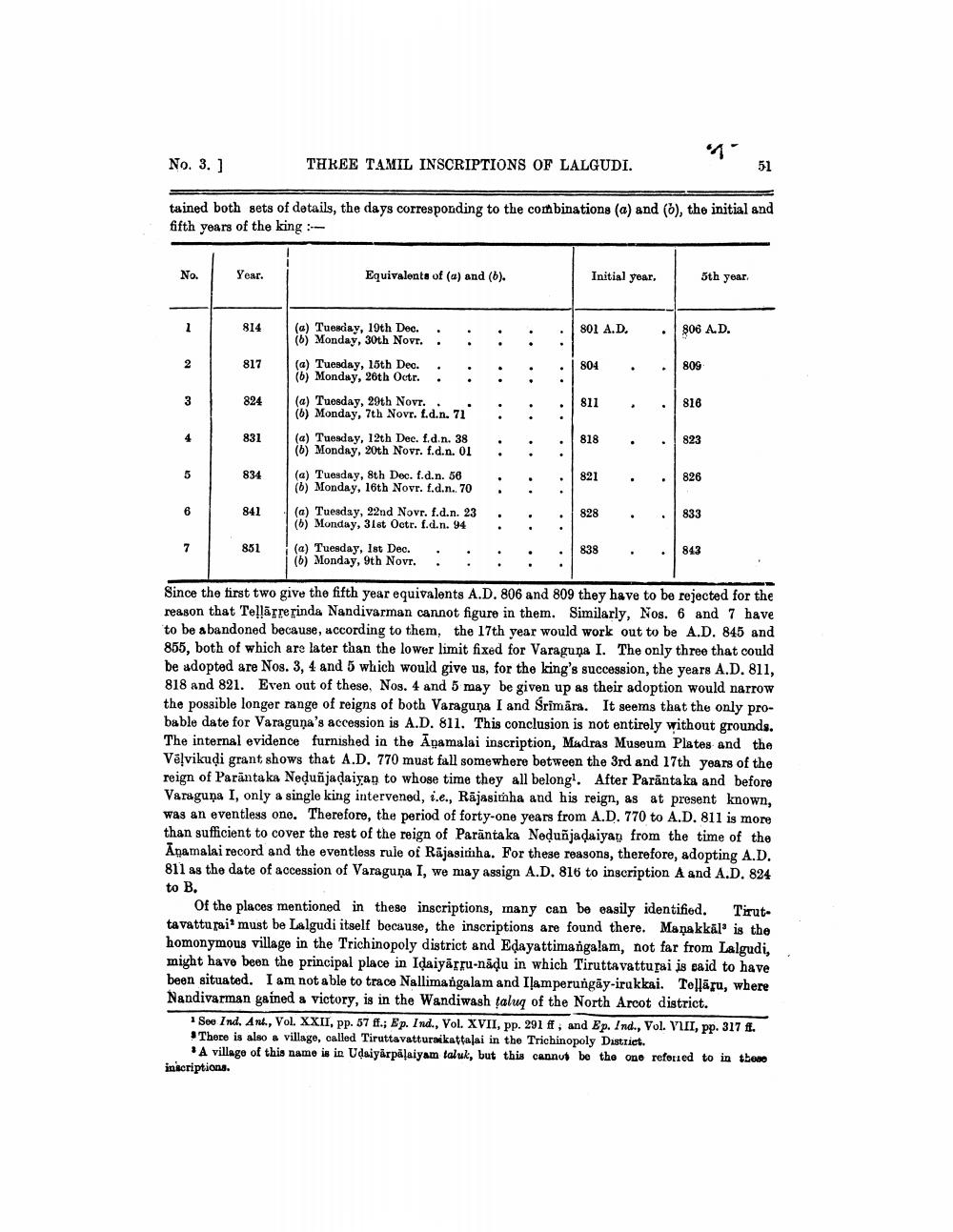________________
en
No. 3. ]
THREE TAMIL INSCRIPTIONS OF LALGUDI.
51
tained both sets of details, the days corresponding to the combinations (a) and (b), the initial and fifth years of the king :
No.
Year.
Equivalents of (a) and (6).
Initial year.
5th year.
(a) Tuesday, 19th Dec.
.
.
801 A.D.
806 A.D.
. .
.
.
. .
804
.
. :
.
(a) Tuesday, 13th Dec. . . (b) Monday, 26th Octr. . . (a) Tuesday, 29th Novr. . . (6) Monday, 7th Novr. .d.n. 71 (a) Tuesday, 12th Dec. f.d.n. 38 (6) Monday, 20th Novr. f.d.n. 01 (a) Tuesday, 8th Dec. f.d.n. 56 (b) Monday, 16th Novr. 1.d.n.. 70
.
.
(a) Tuesday, 22nd Novr. f.d.n. 23 (6) Monday, 31st Octr. f.d.n. 94
. .
. .
. .
(a) Tuesday, Ist Dec. (6) Monday, 9th Novr.
838
843
.
.
.
Since the first two give the fifth year equivalents A.D. 806 and 809 they have to be rejected for the reason that Tellarreginda Nandivarman cannot figure in them. Similarly, Nos. 6 and 7 have to be abandoned because, according to them, the 17th year would work out to be A.D. 845 and 855, both of which are later than the lower limit fixed for Varaguna I. The only three that could be adopted are Nos. 3, 4 and 5 which would give us, for the king's succession, the years A.D. 811, 818 and 821. Even out of these, Nos. 4 and 5 may be given up as their adoption would narrow the possible longer range of reigns of both Varaguna I and Srimára. It seems that the only probable date for Varaguņa's accession is A.D. 811. This conclusion is not entirely without grounds. The internal evidence furnished in the Anamalai inscription, Madras Museum Plates and the Vélvikudi grant shows that A.D. 770 must fall somewhere between the 3rd and 17th years of the reign of Parantaka Neduñjadaiyan to whose time they all belong. After Parāntaka and before Varaguņa I, only a single king intervened, i.e., Rājasimha and his reign, as at present known, was an eventless one. Therefore, the period of forty-one years from A.D. 770 to A.D. 811 is more than sufficient to cover the rest of the reign of Parānta ka Neduñjadaiyan from the time of the Anamalai record and the eventless rule of Rājasimha. For these reasons, therefore, adopting A.D. 811 as the date of accession of Varaguna I, we may assign A.D. 816 to inscription A and A.D. 824 to B.
Of the places mentioned in these inscriptions, many can be easily identified. Tiruttavattu pai. must be Lalgudi itself because, the inscriptions are found there. Manakkal' is the homonymous village in the Trichinopoly district and Edayattimangalam, not far from Lalgudi, might have been the principal place in Idaiyārru-nādu in which Tiruttavatturai is said to have been situated. I am not able to trace Nallimangalam and Iļamperungäy-irukkai. Tollāru, where Nandivarman gained a victory, is in the Wandiwash taluq of the North Arcot district.
1 See Ind. Ant., Vol. XXII, pp. 57 ff.; Ep. Ind., Vol. XVII, pp. 291 ff, and Ep. Ind., Vol. VIII, pp. 317 f. .There is also a village, called Tiruttavatturaikattalai in the Trichinopoly District.
A village of this name is in Udaiyarpalaiyam taluk, but this cannot be the one refonied to in those inscriptions




